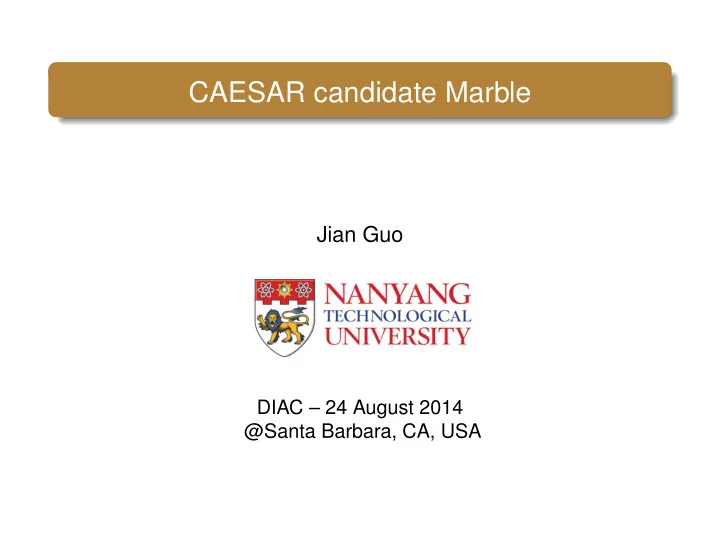

CAESAR candidate Marble Jian Guo DIAC – 24 August 2014 @Santa Barbara, CA, USA
Design Goals ◮ Online ◮ Parallelizable ◮ Software oriented ◮ Decryption-misuse resistant, unverified plaintext release ◮ Nonce-misuse resistant, or nonce-free ◮ Low setup overhead ◮ Support of extreme usecases ◮ Full security 2 / 11
The need of “wide-pipe” Lesson from hash function development use double or even larger internal state to avoid internal collisions 3 / 11
Design Overview ◮ E 1 , E 2 , E 3 are block-ciphers ◮ TRANS ( x , y ) : a transition function with MDS property. ◮ ‘ · ’ multiplication is in GF ( 2 128 ) . 4 / 11
Recommended Parameters Choices are made to optmize the software performance: ◮ E 1 , E 2 , E 3 are 4-round AES, every message block is processed by 12 AES rounds. ◮ TRANS ( x , y ) = ( x + y , 3 · x + y ) , division-free for the inverse computation. 5 / 11
Recommended Parameters Choices are made to optmize the software performance: ◮ E 1 , E 2 , E 3 are 4-round AES, every message block is processed by 12 AES rounds. ◮ TRANS ( x , y ) = ( x + y , 3 · x + y ) , division-free for the inverse computation. achieve a speed of 1.6 cpb for long message and 1.7 cpb for 8KB message, tested on Intel(R) Core(TM) i5-4570 CPU @ 3.20GHz (Haswell Family), 12 rounds AES takes 0.6 cpb only, room to improve. 5 / 11
Recommended Parameters Choices are made to optmize the software performance: ◮ E 1 , E 2 , E 3 are 4-round AES, every message block is processed by 12 AES rounds. ◮ TRANS ( x , y ) = ( x + y , 3 · x + y ) , division-free for the inverse computation. achieve a speed of 1.6 cpb for long message and 1.7 cpb for 8KB message, tested on Intel(R) Core(TM) i5-4570 CPU @ 3.20GHz (Haswell Family), 12 rounds AES takes 0.6 cpb only, room to improve. Options ◮ support the use of 128-bit nonce, by prepending it to the associated data. 5 / 11
Recommended Parameters Choices are made to optmize the software performance: ◮ E 1 , E 2 , E 3 are 4-round AES, every message block is processed by 12 AES rounds. ◮ TRANS ( x , y ) = ( x + y , 3 · x + y ) , division-free for the inverse computation. achieve a speed of 1.6 cpb for long message and 1.7 cpb for 8KB message, tested on Intel(R) Core(TM) i5-4570 CPU @ 3.20GHz (Haswell Family), 12 rounds AES takes 0.6 cpb only, room to improve. Options ◮ support the use of 128-bit nonce, by prepending it to the associated data. ◮ Better security margin with AES for E 1 , E 2 , E 3 , yet with a speed of 3.0 cpb. 5 / 11
Usecases In addition to the usual use, Marble supports many extreme usecases: ◮ Encryption/Decryption only (opting out the tag) ◮ Integrity of associated data only. ◮ Integrity of message — MAC only (opt out the ciphertext). 6 / 11
Security Goals 2 n security, not “birthday bound”, in both nonce-respecting and nonce-misuse scenarios. 2 128 Privacy 2 128 Authenticity 7 / 11
Security Goals 2 n security, not “birthday bound”, in both nonce-respecting and nonce-misuse scenarios. 2 128 Privacy 2 128 Authenticity Privacy in nonce-misuse scenario: prefixed message blocks share the same ciphertext prefix. 7 / 11
Security Evaluations ◮ Differential/Linear Cryptanalysis: any complete path will involve at least 12 rounds AES, with 75 active sboxes. ◮ Inner collisions: collision on single chain is NOT “detectable”; collision on double chains requires 2 n . ◮ Nandi’s attack does not apply even with complexity 2 n due to the 2 n -bit chain. 8 / 11
Security Proof We welcome security proof of Marble mode, when the three block ciphers are idealized. 9 / 11
Future work ◮ Hardware implementations ◮ Improving the software implementations with AES-NI ◮ Implementations without AES-NI ◮ Implementations for Atmel AVR ◮ Security proof when the underlying blockciphers are ideal, extend tag-splitting to arbitary-length message to avoid XLS. 10 / 11
Thank you! Questions? 11 / 11
Recommend
More recommend